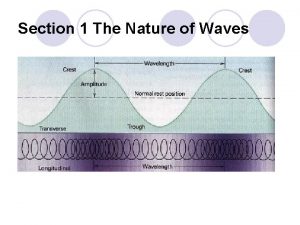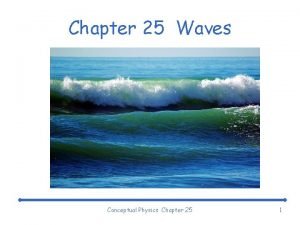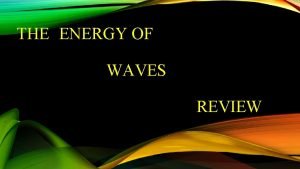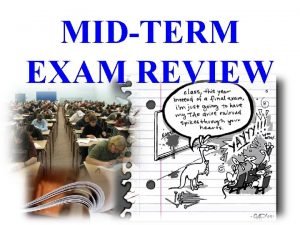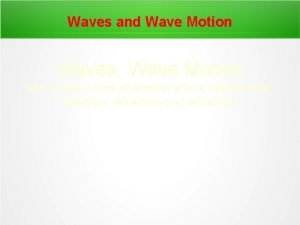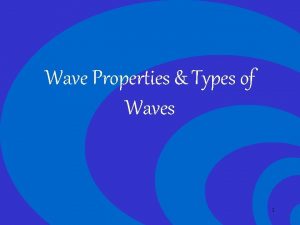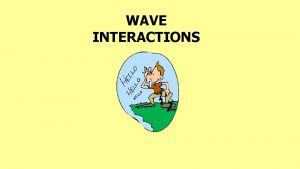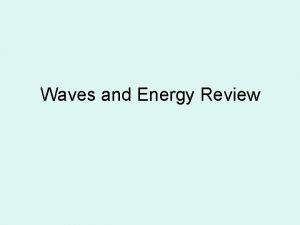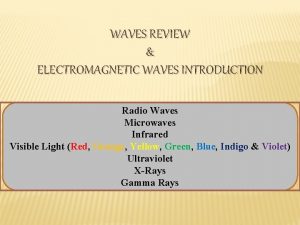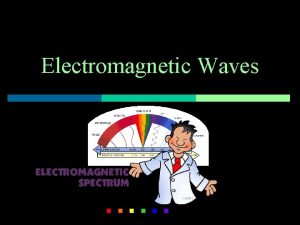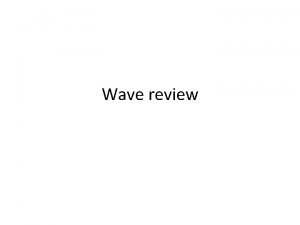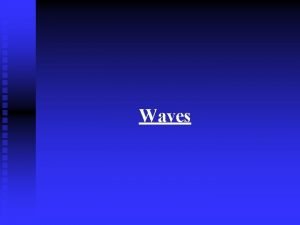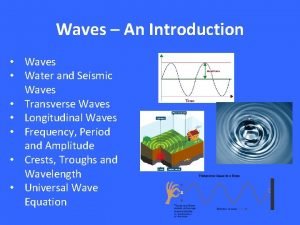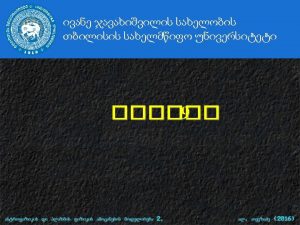Wave Term Review Waves 1 A wave is












































- Slides: 44

Wave Term Review

Waves 1) A wave is any disturbance that transmits _______ through matter and space.

Kinds of Waves 2) A _____wave is a wave where the material that the wave is in vibrates back and forth along the path that the waves travels.

Kinds of Waves 3) A _____ wave is a wave where the material that the wave is in moves perpendicular (at right angles) to the direction that the wave is traveling.


What type of wave is this?


Which wave below has a higher frequency? A B

The maximum distance a wave vibrates from its rest position is called the wave’s _______.

Which one of these waves has a larger amplitude? A B C

A _____ is the distance from any point on one wave to that same point on the next wave.

Which one of these waves has a larger wavelength? A B

The number of waves (or cycles) produced in a given amount of time is called the _______ of a wave.

Which one of these waves has a higher frequency?

The distance between what two letters is a wavelength (λ)?

Draw a longitudinal wave. Label a wavelength. Label a compression and rarefaction.

Identify what the arrow is showing. ? ? ?

Draw a transverse wave. Label the crests and troughs. Label a wavelength. Label the amplitude.

Review

Sound waves are reflected at a boundary. http: //www. surendranath. org/Applets/Waves/Twave 02 Applet. html

Sound waves are refracted at a boundary.

Interference. – Constructive interference – Destructive interference

Here’s what is occurring. (SIM 1) (SIM 2)

Beating Frequency (SIM 1) (SIM 2)

Multiple sound sources interfere (SIM) Changing separation distance.

Multiple sound sources interfere. Changing source frequency.

Resonance. – All elastic objects have natural frequencies of vibration that are determined by the materials’ compositions and shapes. – When energy is transferred at the natural frequencies, there is a dramatic increase of amplitude called resonance. – The natural frequencies are also called resonant frequencies.

When the frequency of an applied force, including the force of a sound wave, matches the natural frequency of an object, energy is transferred very efficiently. The condition is called resonance.


Sources of Sounds Vibrating Strings. – Standing Waves (animation) – Nodes and Anti-Nodes – Fundamental Frequency • The fundamental frequency determines the _____ of the basic musical note being sounded and is called the ____ harmonic.

In illustration C: How many nodes? How many antinodes?

The beginning overtone series for a vibrating string fixed at both ends. (SIM)

Why do different voices and instruments produce unique sounds? Timbre (sic) - A combination of the fundamental and overtone frequencies produces a composite waveform with a characteristic sound quality.

Closed tube

Open tube

– Overtones for a string (fixed at both ends) or Open Tube (open at both ends) – Overtones for a closed tube (closed at one end and open at the other) – SIM 1

Do nodes or antinodes appear at the open ends of these pipes? Which pipes produce the longer wavelength? Higher pitch?

Pitch depends on length. Which trombone has the longer wavelength? Higher pitch? A B Do nodes or antinodes appear at the mouthpiece? Bell?

Harmonic Series 1 st 4 th 2 nd 5 th 3 rd What kind of tube (open vs closed) would these wave diagrams describe?

Sounds from Moving Sources – Doppler Effect (Animation) – Sonic Boom

Sound from: A stationary object A moving object (SIM 1) (SIM 2)


Final Note: Mechanical waves and Electromagnetic Waves are different!

Sources: Bloomfield, How Things Work. Krauskopf & Beiser, The Physical Universe. 10 th ed. Tillery, Physical Science. www. physicsclassroom. com
 Similarities of mechanical waves and electromagnetic waves
Similarities of mechanical waves and electromagnetic waves Longitudinal vs transverse wave
Longitudinal vs transverse wave Mechanical wave examples
Mechanical wave examples Difference between mechanical and electromagnetic waves
Difference between mechanical and electromagnetic waves The wave chapter 13
The wave chapter 13 Is echolocation transverse or longitudinal
Is echolocation transverse or longitudinal Long waves and short waves
Long waves and short waves Difference between matter waves and electromagnetic waves
Difference between matter waves and electromagnetic waves Mechanical vs electromagnetic waves
Mechanical vs electromagnetic waves Mechanical waves and electromagnetic waves similarities
Mechanical waves and electromagnetic waves similarities Surface waves and body waves
Surface waves and body waves Seismic waves are mechanical waves
Seismic waves are mechanical waves Compare and contrast p waves and s waves using venn diagram
Compare and contrast p waves and s waves using venn diagram Mechanical wave and electromagnetic wave
Mechanical wave and electromagnetic wave Difference between constructive and destructive waves
Difference between constructive and destructive waves Ability of two or more waves to combine and form a new wave
Ability of two or more waves to combine and form a new wave Conceptual physics chapter 25
Conceptual physics chapter 25 Short, medium and long term planning in education
Short, medium and long term planning in education In my understanding
In my understanding Long term memory vs short term memory
Long term memory vs short term memory Quadratic sequence formula
Quadratic sequence formula Short term human resource planning
Short term human resource planning Position-to-term
Position-to-term Difference between long term and short term liabilities
Difference between long term and short term liabilities Long-term liabilities examples
Long-term liabilities examples Maxterm expansion
Maxterm expansion Rules in finding the nth term
Rules in finding the nth term Term to term rule
Term to term rule Long term goals examples
Long term goals examples Short term finance planning
Short term finance planning Match the wave term to its correct description.
Match the wave term to its correct description. Difference between full wave and half wave rectifier
Difference between full wave and half wave rectifier Compare and contrast transverse and longitudinal waves
Compare and contrast transverse and longitudinal waves Half wave rectifier meaning
Half wave rectifier meaning Full wave rectifier
Full wave rectifier P and s wave chart
P and s wave chart Full wave rectified sine wave fourier series
Full wave rectified sine wave fourier series Longitudinal wave
Longitudinal wave The nature of waves chapter 10 section 1
The nature of waves chapter 10 section 1 Even symmetry fourier series
Even symmetry fourier series Transverse wave and longitudinal wave example
Transverse wave and longitudinal wave example Mid term review format
Mid term review format Chapter review motion part a vocabulary review answer key
Chapter review motion part a vocabulary review answer key Uncontrollable spending ap gov
Uncontrollable spending ap gov Nader amin-salehi
Nader amin-salehi















